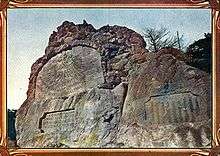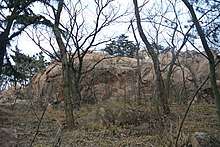Diederichs's stone
The Diederichs's stone (German: Diederichsstein, Chinese: 迪特里希碑; pinyin: Dítèlǐ Xībēi) was a German monument in the city of Qingdao to commemorate Admiral Otto von Diederichs and the German occupation of the Kiautschou Bay concession on November 14, 1897. The monument was dedicated on November 21, 1898 by Prince Henry of Prussia.[1] It was located at an elevation of 98 m, about halfway up the southwestern slope of the Signal Hill, the official German name of the mountain at the time was "Diederichsberg"[2]. Its most prominent feature was a plate decorated with the imperial eagle of the German Empire and the inscription "For him who won for Kaiser and Reich the land all around, let this rock be named Diederichs's stone" ("Der hier für Kaiser warb u. [und] Reich ringsher das Land, nach ihm sei dieser Felsen Diederichsstein genannt").[3] Below the plate was a rock inscription that read, "In this place on November 14th, 1897, Admiral v.[von] Diederichs took possession of the Kiautschou territory" ("Am 14. November 1897 ergriff an dieser Stelle der Admiral v.[von] Diederichs Besitz vom Kiautschou Gebiet"). A separate Chinese inscription was located to the right-hand side of the German text. The entire monument stood about 5 meters tall.


After Japan occupied Qingdao in November 1914, a Japanese inscription (executed using Chinese characters: 大正三年十一月七日, "November 7 of the third year of the Taishō period") was placed across the imperial eagle. When Japan handed Qingdao back to China on December 10, 1922, the monument was dismantled and parts taken to a military museum in Tokyo.[1]
Bibliography
- Torsten Warner: Deutsche Architektur in China. Ernst & Sohn, 1994, ISBN 3-433-02429-4.
- Hans Weicker: Kiautschou. Das deutsche Schutzgebiet in Ostasien. Federzeichnungen, Initialen und Vignetten von Marie Gey-Heinze. Alfred Schall, Berlin 1908.
- Michael Salewski: Die preußische und die Kaiserliche Marine in den ostasiatischen Gewässern: Das militärische Interesse an Ostasien.
References
- Torsten Warner: Deutsche Architektur in China, Ernst & Sohn, 1994, page 98
- Signalberg, Deutsches Kolonial-Lexikon (1920), volume III, page 357
- Terrell D. Gottschall, By Order of the Kaiser: Otto Von Diederichs and the Rise of the Imperial German Navy, 1865–1902, Naval Institute Press, Jan 1, 2003
| Wikimedia Commons has media related to Diederichs's stone. |